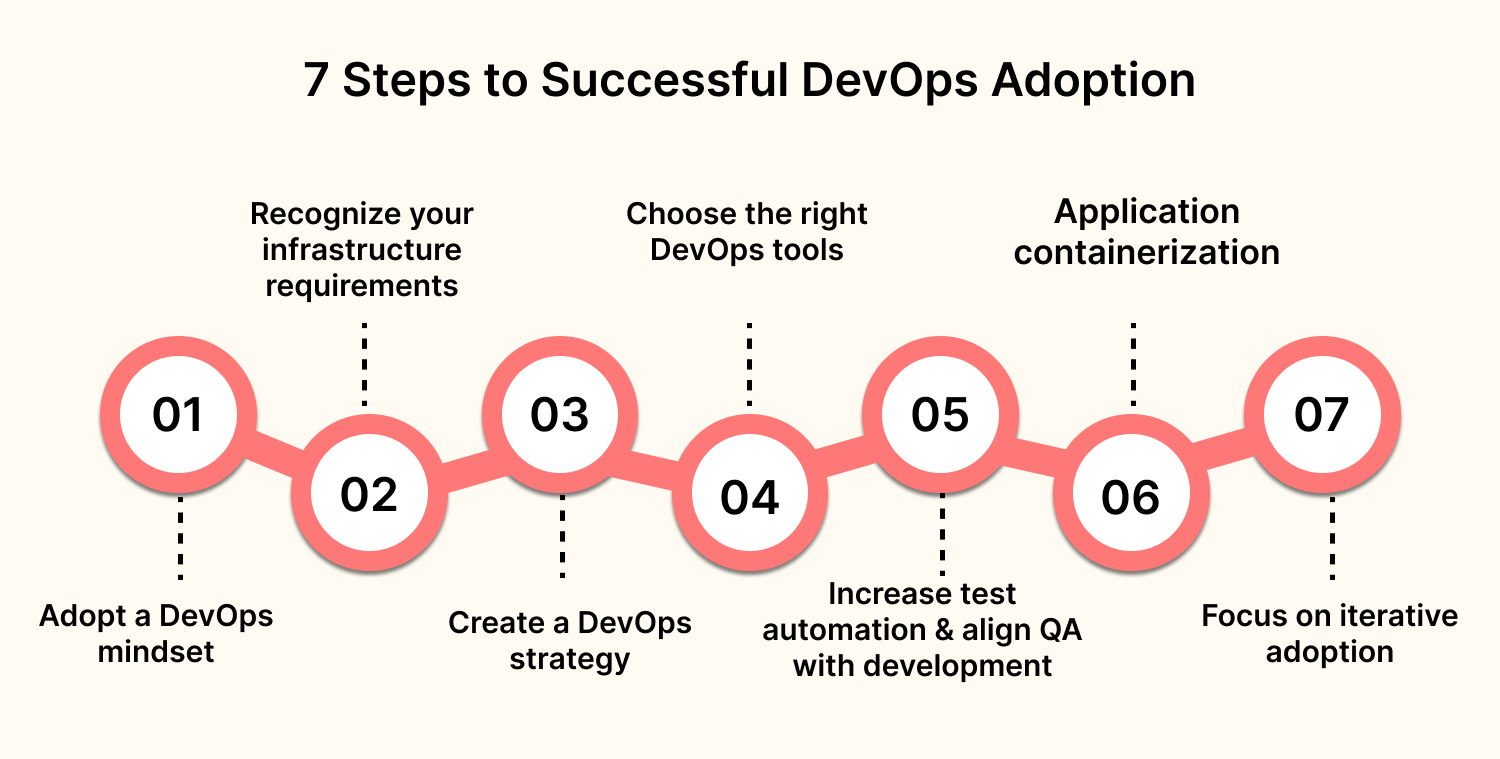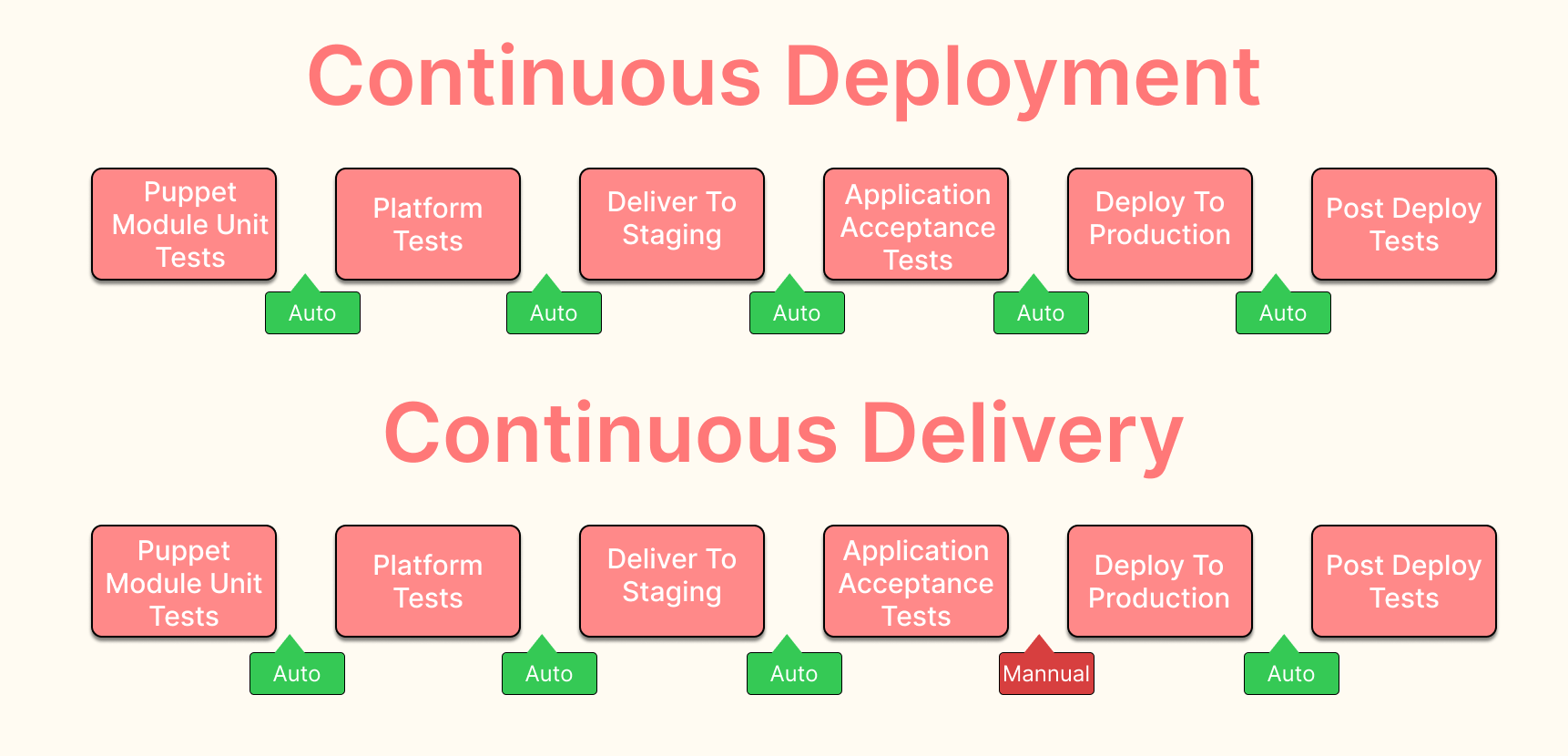Growing implementations of DevOps solutions across companies marked a giant leap in industrial digital transformation. Next-gen cloud adoption in large-scale organizations enables a strong relationship between development, security, and operations to achieve sustainable growth.
However, DevOps adoption is an overwhelming challenge and a roadblock to leveraging the entire I.T. infrastructure. With growing automation and high-performance benchmarks, it is now an irrefutable project for the tech landscape.
Tech enthusiasts worldwide explored diverse methodologies and techniques to include in their processes. Although some encountered failure, many got successfully established as a base for DevOps deployment. However, DevOps’s overwhelming adoption slows down the initiatives for an end-to-end transition of the development pipeline.
Faster release cycles, enhanced scalability, improved code quality, and better risk management are some of the outstanding benefits of DevOps services and solutions for large enterprises. However, achieving it is not a cakewalk. Let’s understand the implementation details of enterprise DevOps.
What Is the Role of Enterprise DevOps Solutions?
DevOps was first created in 2009 by Patrick Debois and originated from development and operations. It is not a technology, framework, or tool, but a set of processes that bridge the gap between a company’s development and operations team. The goal is to remove the roadblocks to communication and facilitate teamwork.
While dealing with standard DevOps methodology, the focus lies on creating automation in the CI/CD pipeline. Enterprise DevOps analyze all the requirements in detail to provide a simplified meaning to each automation process. It is all about doing things at an exponential level to promote reliability and availability all around.
Another crucial aspect of enterprise DevOps solutions that makes it different from other standard DevOps practices is its great emphasis on security. The enterprise-level organizations should comply with standards that promote the privacy and security of confidential data information.
Also, DevOps increases the efficiency of a business software delivery ecosystem to facilitate quick software delivery, improved collaboration, automation, and more. Success in DevOps doesn’t come overnight, despite how professionally you deploy the entire process. Enterprises must focus on raising the level of information technology delivery to reach their desired objective.
DevOps can work wonders on large-scale organizations that may face scenarios like:
- Difficulty managing monolithic or a static software
- Want to optimize the workflows that are primarily manual and prone to errors
- Managing multiple interdependent and related subsystems
- Ensuring compliance with security, financial, medical, or any other standard
- Waterfall model-based processes in multiple teams
What are the Advantages of DevOps Implementation?
DevOps is the combination of people, processes, and products that enables continuous delivery of value to the end users. Teams can now streamline their software development and delivery. DevOps consulting services do not remove any quality and security expectations, but the teams that own quality and security can implement these requirements to reduce vulnerabilities. Let’s look at the major benefits of DevOps:
Happy Workforce
One of the major advantages of adopting DevOps practices is your employees will be happy always. When implemented professionally, employees are provided with the autonomy to improve work processes, patterns, and technology throughout the organizational streams. This experimentation, learning, and ownership keep employees engaged and give them a sense of purpose. Also, it assists them in creating valuable culture, reducing hassles, and attracting more talent.
Improved Workflow
Another significant advantage of DevOps solutions adoption is its features to improve the workflow. Improvements made in the organizational workflows can reduce the bottlenecks, improve time to market, and help quickly address the customer’s demands. It enables competitive advantages in the market while dramatically reducing the cost of delay. Above all, it improves the throughput flow of your stream allowing agility within the delivery. Therefore, the allotted agility provides a mechanism to experiment, learn, and achieve customer satisfaction at a rapid pace. As a result, it will place your organization ahead of the competition.
The agile delivery process is crucial to sustaining long-term customer retention. Implementing DevOps services and solutions together with iterative delivery and automation allows great involvement of the cross-functional teams.
Automated Repetitive Tasks
Automation offers diverse benefits and is directly related to the cost reduction drivers we discussed previously in this blog. However, its benefits are not limited to cost savings. In many scenarios, some work processes are less feasible than the efficient devops automation process. It often happens because automating some tasks automatically frees up time and capacity. As a result, it allows developers to perform other crucial tasks for the solution’s delivery.
Above all, it encourages more advanced improvements like automated tests and code quality analysis in the organization’s atmosphere. Additionally, automation is a significant mechanism that helps reduce and avoid errors that may compromise the project delivery time. DevOps reduce the energy expenditure of teams by helping them get highly motivated, creative, and analytical. And that’s not all you can dramatically accelerate business transformation using techniques like AI integration with DevOps.
Enhanced Collaboration
Successful DevOps implementation is only possible if the company adopts new organizational culture – one that’s more integrated with greater collaboration and communication between various sectors. As a result, the market works in an integrated, synergistic, and interconnected manner.
Therefore, DevOps adoption is crucial in every large-scale enterprise. Adapting to new tools and upskilling your employees is a professional and trusted way of increasing leads naturally. Create a modern, integrated, collaborative, consequently, and efficient organizational culture.
How to Successfully Implement DevOps Solutions in Enterprises?
The idea of DevOps is not new, but many firms lack an understanding of this entire practice. Also, some organizations face trouble using DevOps to achieve their desired results. If it sounds like you, here are the steps to successfully adopt DevOps to your enterprise.
Practice a DevOps Mindset
Before implementing DevOps solutions, every stakeholder in the organization must have the mindset to change the way things get done, and a clear picture of how DevOps addresses business demands. Organizations frequently misunderstand automation as DevOps. While automation helps speed up manual operations, cooperation and communication are the key objectives of DevOps. Automating your operations won’t offer desired business benefits unless every employee in the software development team, delivery, testing, and operations adopts impressive communication and collaborative practices.
The best way to implement DevOps solutions is to make sure everyone is on the same page and has an innovative mindset. Employees participating in the process should be aware of their job responsibilities and well-trained to follow the organization’s work culture. For successful DevOps implementation, the organization’s leadership must have confidence in it and assistance in fostering the DevOps culture around the organization.
Understand the Organization’s Infrastructure Requirements
Take from the experts with 20+ years of DevOps experience, there is no “one size fits all” DevOps solution. You cannot hire DevOps developer or switch to an online tool for a successful result. Every organization’s DevOps journey will be unique and based on its business culture, work processes, and infrastructure. The most significant step to success is to have an in-depth knowledge of your application’s requirements. It enables you to make DevOps adoption business-driven and address your infrastructure architecture with organizational long-term goals.
Examine your project delivery cycle and testing environments to find areas of improvement and possible bottlenecks. Also, your DevOps adoption won’t be successful without the integration of CI/CD (Continuous Integration and Continuous Delivery) pipelines into your workflow.
After all, Continuous Delivery enables your development team to deploy changes in production, and Continuous Integration helps develop a product in small phases and identify and rectify faults.
Create a Robust DevOps Strategy
The program managers must establish a shared objective to bring teams together in a comprehensive setting. The goal should be to add a sense of responsibility and obligation to every team member. DevOps relies on best practices that promote innovative approaches to software development, architecture, and testing while enhancing the entire teamwork.
Every organization’s strategy must focus on two objectives – help the team as a whole and facilitate the continuous deployment of processes that are ready for production.
Choose the Right DevOps Solutions & Tools
There isn’t a single tool that can manage all the demands and key purposes of DevOps. The best solution is to choose a set of tools that are ideal for the organization’s software delivery environment, applications, teams, and so on.
The appropriate tools help organizations establish a solid DevOps framework, and accomplish a continuous process from development to delivery, resource, and cost optimization to understand organizational goals. Also, organizations must consider the following factors while choosing an appropriate DevOps tool:
The desired tool must have the ability to offer enterprise-level automation. Without many challenges, it will assist in scaling business workflows, and constantly improve operations.
- Integrating the entire delivery ecosystem is a must in DevOps
- Increase test automation and align QA with development
DevOps need quality automated testing to achieve quick delivery. Not all testing types require automation. For instance, manual testing is mandatory for investigative, security, and usability testing. Functional testing being partially automated depends on the amount of writing effort required.
Development and testing are done simultaneously to prevent bug post-release. The recommended approach is to run automated tests 1-2 times per day while the program is still in the development phase. In case of any issues, developers can focus on stabilizing the software before deploying the final product.
Application Containerization
Application containerization is a rapidly developing technology that alters how cloud-based application instances get tested and ran by developers. For instance, your program becomes lightweight and simple in execution when containerized.
Software, when used, reliability increases with container packaging. Additionally, the software becomes independent of the broader infrastructure, thanks to its container components. It improves its ability to operate independently in any context. Containerizing enables DevOps teams to quickly manage the application and make the adjustments required for a specific microservice.
Focus on Iterative Adoption
Avoid launching an end-to-end DevOps solutions plan in the enterprise while just getting started for obvious reasons. Instead, choose a pilot application, and put together a cross-functional DevOps team made up of developers, testers, and operations personnel. Also, you can assess your value stream to discover bottlenecks and restrictions and develop a preliminary deployment pipeline that requires a few process constraints into account.
Track your success and growth, then repeat the process. Before thinking about expanding the additional projects, assess a few iterations to gain trust in the framework and the pilot.
Since doing so would create a great commercial impact, start by addressing your largest value-stream restrictions. Some of these restrictions will be simple, while others may require time.
What are the Major Challenges of DevOps Solutions Adoption?
We’ve discussed how to adopt enterprise DevOps and some of the advantages of implementing it in your workflow culture. However, it is not easy to consider all the factors and implement DevOps perfectly in your organization’s ecosystem. Let’s discuss the challenges associated with DevOps services and solutions.
Culture
Transforming an organization’s culture is one of the major challenges faced in the entire journey. Chances are, you may have to “grassroots” efforts throughout the multiple segments of the enterprise. Capitalize on these initiatives and provide autonomy to the teams & individuals making efforts for the organization’s goals. Support the innovators and early adopters on which the success of your cultural transformation relies upon.
Insufficient Tools
As tech conglomerates, we often switch to tools to resolve our challenges, which are crucial, but DevOps doesn’t support a defined set of tools or a tech stack alone. Therefore, it is recommended to create a holistic approach to DevOps adoption. It may seem overwhelming but, in the end, you will have an empowering team at all levels. The challenges today will drastically improve your transformation journey.
Overcoming these challenges involves restructuring the work entirely. Therefore, spend more time making the processes visible throughout the organization. Create a plan to flow your products, prioritize, and implement your org strategies. Also, don’t forget your “North Star” which is critical to align all initiatives to your expectations – simply implementing multiple tools will take you nowhere.
Lookout for the technological solutions that best fit your work style, the organizational constraints, and the development goals of each product. It will become easier to understand how automation and tools can optimize your work processes.
Standardization and Data Usage
Irrespective of the specifics of your projects, some DevOps elements are universal. For instance, the need to standardize your platforms to sync up the development and operations. Pay attention to detail to the developer’s experience while standardizing the work environments.
Technology modernization refers to a skill that is in great demand by companies hiring in that profile, which requires improvement. For instance, helping maintain and evolve infrastructure and cloud computing architectures are the most required demands in the market today.
DevOps is an ideal solution for such needs, as the development and administration integration naturally shift the organization towards standardization. This process enables team ownership of the products within the standard environments.
Quality and Security
The most drastic shift for anyone adopting DevOps solutions like the Google Cloud Platform is owning the quality & security of the product. Since development goes hand in hand with operations, it’s obvious for professionals to neglect some steps in more complex projects.
It is another challenge where the focus is on project deadlines and meeting the customer’s needs while security can fall apart. Changing the approach to prioritize the customer’s needs includes a secure product. Traditional project management focuses on deadlines vs quality – which must change. A product delivered with loopholes and vulnerabilities is not a valuable delivery for the customers and your business in the long term.
It is one of the many reasons why companies are turning to DevSecOps –development, security, and operations — to work together with common goals. These segments of work must shift to the left and the product teams should own most of these work processes. The success of DevOps consulting services is possible when you bring together the technical and business expectations like investing in services that can safely drive toward productivity. After all, success is not about well-written code but the ability to integrate quality in every value stream.
How to Start with DevOps Adoption?
It’s a common practice for many organizations to replace their best practices with popular DevOps best practices for business needs. However, it doesn’t work in every situation. Therefore, don’t replace what works best for you. Instead, introduce some new adjustments to efficiently minimize risks and increase workplace efficiency. Here are a few things you can get started with:
Change the Work Culture Environment
To begin with, it’s evident to have cross-functional teams who can take ownership of the development, security, and operational functions of their products. For this integration to get successfully launched, synergy and collaboration between the areas are a must.
Prioritize Learning
Building a work culture where learning is essential will truly move toward success. Incentivize and invest in team learning to improve the quality of value delivery and improve your organization’s employee retention and new talent acquisition. Many organizations are focusing on immersive learning and enablement practices to upskill the team.
Unlike traditional corporate training, immersive learning focuses on team uplift on their actual work and within the existing constraints. With repetition and coaching support, the team grows and upskills to effectively learn for long-term success.
Continuous Integration
If your team hasn’t adopted a robust continuous integration practice, emphasize it on a priority basis. With continuous integration, code gets built and reviewed with a series of automated testing at every check-in. It prevents quality risks and provides early feedback that developers can address right away. Furthermore, some of these tests should be done for local development to hold themselves accountable for fast, cost-effective feedback prior to pushing up their changes.
Implement Test automation
Automated tests are evident throughout the software delivery lifecycle. Developers must primarily focus on creating and maintaining automated test suites. Throwing any of the work to another team is a severe concern and must get addressed on high priority.
Constant Delivery
Every product team is expected to deliver continuously. The software must be in a deployable state throughout its lifecycle, and the team should prioritize keeping the software in a deployable state while working on other features. With continuous integration practices in place, the team will have the confidence to commit to deploying to production environments. Any impediments in this cycle should be made visible and addressed immediately.
What are the Key Principles for DevOps Implementation at Scale?
We’ve discussed some practical tips for DevOps implementation in an enterprise setup. Now, let’s look at some fundamental principles to keep in mind while implementing DevOps in your organizational workflows.
Principle 1: Centralized End-to-End Management
Get a centralized management system for your DevOps solutions pipeline with both development and deployment teams to operate as centrally managed teams. The goal is to ensure better visibility for all development and operational teams.
Principle 2: Security is Paramount
Enterprise DevOps consulting services must focus on security and compliance-related issues from the start of the software development lifecycle. Maintain continuous and automated scanning at the database level, enable universal compliance issues, and set up governance teams to monitor rules and compliance policies.
Principle 3: Cloud-Native Modernization
Move to a cloud-native environment to gain a competitive advantage and offer effortless infrastructure management. With serverless platforms like AWS Lambda and Azure, organizations can manage networking, storage, and cloud provisioning with ease.
Principle 4: Pipeline as a Code
It is a standard practice of defining deployment pipelines via source codes. It will help reduce the developer’s workload and allow them to standardize and automate the process of software development
Wrapping up
There is a diverse range of tools, practices, and working patterns that companies can implement to achieve a successful DevOps adoption. Therefore, it is crucial to look for things that can meet all the demands and specifics of your organization and its work culture. The benefits of DevOps solutions create a direct impact on the overall result of the enterprise, which consequently results in business success.
Remember – your people are your asset in sustaining and growing your business. So, invest in your resources, enable, and empower their knowledge and working skills.
Are you looking for DevOps experts who can offer you end-to-end solutions? hire a DevOps engineer from OrangeMantra to accelerate your development pipeline and business growth.
FAQs
What is DevOps Solutions Adoption?
The DevOps adoption model was defined by IBM as a process to help organizations incrementally adopt DevOps features and improve their effectiveness and overall work efficiency. The 4 adoption paths of DevOps are represented as Steer, Develop/Test, Deploy, and Operate.
How to Implement DevOps Step by Step?
The DevOps implementation involves major six steps:
- Introduce DevOps initiative
- Develop DevOps strategy
- Use containerization
- Integrate infrastructure with CI/CD tools
- Choose more test automation and QA-Dev alignment
- Check for application performance monitoring
How to Implement DevOps in an Organization?
- Align your IT goals with business goals
- Encourage collaboration within the team
- Become customer-centric to adapt to the ever-evolving demands of the customers
- Start small and then scale-up
- Automate the processes wherever required
- Select tools that are compatible with each other
- Define performance reviews for the entire organization
- Ensure real-time visibility into the project
- Integrate the key components and deliver continuously
- Attain better results with monitoring & feedback
Why does an Organization Require DevOps Adoption?
DevOps adoption facilitates building a set of capabilities across numerous functions in the organization from people, and processes to tools and workflow. It helps IT processes to stay agile and deliver according to business requirements.
What are the Key Components of DevOps Solutions Implementation?
Some of the key components of DevOps implementation include:
- Continuous integration
- Continuous delivery
- Microservices
- Code infrastructure
- Devops Monitoring and logging
- Communication and Collaboration
Can DevOps get Implemented in any Project?
DevOps adoption must revolve around the best practices associated with it, which include test automation, constant delivery, deployment, configuration management, and more. All these processes help achieve efficiency and accelerate business processes.


























